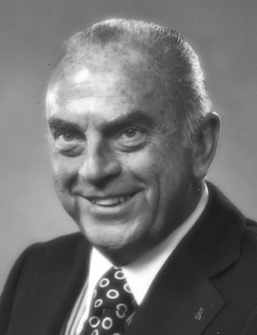
The induction of Clifford A. Parish into the Medical Advertising Hall of Fame marks the first time a pharmaceutical company executive has been elected to “The Hall.” Appropriately, Parish’s position at Burroughs-Wellcome (BW) was that of “advertising manager” or its equivalent in organizational terms. This job description no longer exists at Rx companies with the significance it had from the 1950s to the 1970s, before the product manager system became the model in pharmaceutical marketing.
Parish’s election is well deserved based on his tenure as an ad manager long after the position had been phased out of the industry. Much more important than his longevity were his talents in a job that was a demanding and powerful position. After WWII, when pharmaceutical companies adopted more extensive marketing for the breakthrough drugs that were revolutionizing medicine, advertising and promotional programs were concentrated with the ad manager. The person holding this position directly supervised the important basics of Rx promotion—professional advertising and sales force materials—and also had a strong say in such communication activities as public relations, medical education, patient literature, and convention programs.
This was an expansive, multi-tasked assignment, and ad managers succeeded if they could handle the workload organizationally, had an ear for innovation, and, most importantly, the judgment to choose correctly from the range of diverse ideas they were called upon to evaluate. If they had these skills, they could become extremely powerful within their organizations because they were at the control center of their companies’ promotional programs.
Parish had these necessary qualities as well as a personality that reinforced his status and ability to do the job. He had a pervasive influence throughout his company, typical of the reach of the ad manager position.
Phil Brady, who worked with him at BW and also at one of his agencies, recalls, “He was director of advertising but a lot more than that. He was an astute marketing expert, a strategist. He understood CME and public relations. There wasn’t a part of that organization—from research to development—that Cliff didn’t have a pulse on, and he could put it all together. He knew how to make things happen.”
He also brought new ideas to Rx promotion. Under Parish’s direction, BW was one of the first to employ a celebrity spokesperson in a pharmaceutical company’s advertising campaign. NASA had sent BW’s Actifed with astronauts on space flights, and Parish secured the astronaut Wally Shirra to appear at BW booths at medical conventions, generating long lines to meet the hero. Parish also was early in recognizing the potential for PBS sponsorship for corporate programs and linked BW with a medical education series.
With so much responsibility, ad managers had to mobilize those around them to handle their workload, and Parish was an outstanding motivator.
Ron Souza, who was with a BW agency, explains, “Cliff was so bright and so demanding in a genteel way that you wanted to work with him. You wanted to not disappoint him. He had an unu sual enthusiasm for what he was doing and its importance. That just rubbed off on everybody. We wanted to satisfy him.”
Parish’s personality and management approach made an impression on a generation of BW employees, the staffs of his advertising agencies, and with industry people. He was known as someone who did not flaunt his power, but who used it diplomatically.
Tony DiRollo, a veteran publication representative, says of him, “When I think of Cliff, I think about his humanity to everyone. He treated everyone with respect and dignity.”
Accordingly, he was known as the consummate gentleman among ad managers. Parish liked the entertainment side of the advertising business, but he reciprocated in kind by inviting suppliers to his home in Raleigh. He is well remembered for his sartorial style.
Says DiRollo, “He wore the greatest ties I’ve ever seen on any man in the industry, and his sports jackets used to be unique.”
“Cliff had a presence,” comments Souza. “He would walk into a room, he would be nattily dressed, with his crew cut, his tan, and when he walked in, you’d look up and say, ‘There’s someone with substance, there’s somebody that you really wanted to know.'”
Parish was extremely active in trade associations and on the boards of a number of medical foundations. For a number of years he represented the Rx industry on the board of the Business Publications Audit of Circulation (BPA), where he worked to raise auditing standards. He served in these capacities, according to Brady, as an ambassador for the industry.
Parish retired in 1987 after 39 years with Burroughs-Wellcome.
He represents a class of pharmaceutical company advertising executives who have passed beyond the memory of today’s ad agency executives. Parish’s election calls attention to the fact that the legendary agency names that the MAHF has honored—Sackler, Sudler, Hennessey, Klemtner, Phibbs, Kallir, and Corbett, for example—had their counterparts in the ad managers at companies like CIBA, Warner Chilcott, Lederle, Ayerst, Searle, McNeil, Parke-Davis, and Upjohn. The kind of judgment and promotional instinct that Parish had was also present at “the clients” who bought the ideas, funded the programs, and were essential collaborators in the creation of today’s medical advertising.